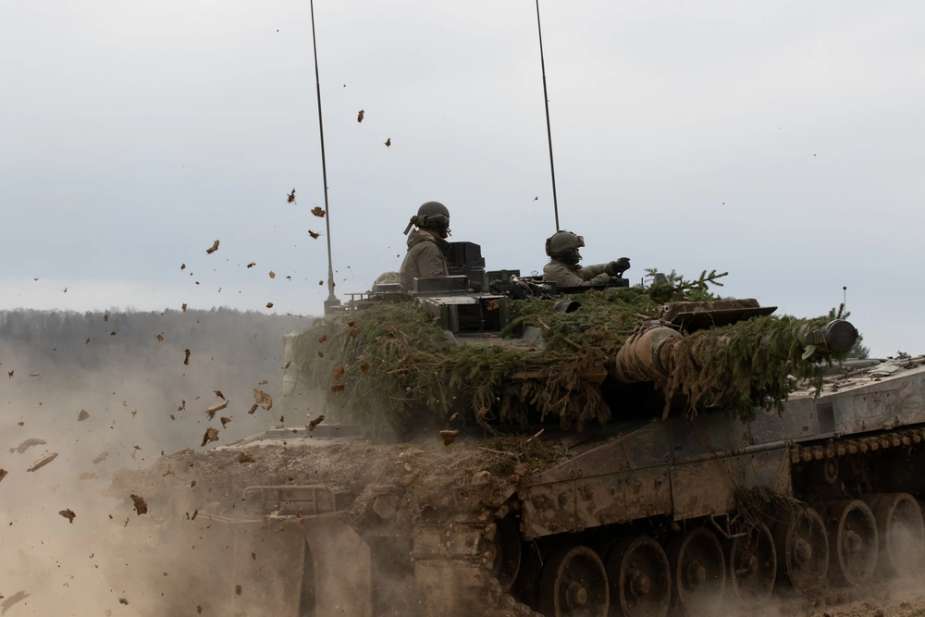Netherlands and Germany show strength in exercise Allied Spirit 24
In a concerted effort to strengthen alliances and improve combat readiness across its member states, the 414 Panzer Battalion of the Royal Netherlands Army, a joint unit comprising German and Dutch forces, participated in Exercise Allied Spirit 24 at the Joint Multinational Readiness Center in Hohenfels, Germany, on March 10, 2024.
Follow Army Recognition on Google News at this link

Leopard 2A7 Main Battle Tank during the exercise Allied Spirit 24. (Picture source: US DoD)
This exercise underscores NATO's commitment to strengthening bonds and enhancing readiness among its members through strategic and comprehensive training.
Allied Spirit 24, a key exercise in NATO's training calendar, focuses on developing interoperability and readiness between NATO allies and partners. It is distinguished by its emphasis on a single allied unit, in this case, the 41st Panzergrenadier Brigade of the German Army, as the main training audience, marking a departure from other exercises often dominated by American units. With approximately 6,500 participants from various NATO allies and partner countries, this exercise demonstrates a multinational effort to bolster the NATO alliance's defense capabilities.
The 414 Panzer Battalion, operational since 2019, represents an avant-garde model of military cooperation in Europe. Comprising about 100 Dutch soldiers and 300 German soldiers, this unit reflects deep military integration between Germany and the Netherlands. Operating under the aegis of the 43rd Mechanized Brigade of the Netherlands and the 1st Panzer Division of Germany, it symbolizes a step towards the concept of a European army. The battalion's main equipment includes the Leopard 2A7 main battle tanks, enhanced with a Dutch battlefield management system, increasing its operational capabilities and interoperability within NATO's Very High Readiness Joint Task Force (VJTF).
The Leopard 2A7's main armament includes a 120 mm / L55 smoothbore cannon, capable of firing with formidable precision. It is also equipped with a 12.7 mm machine gun, a 40 mm grenade launcher, and a 7.62 mm coaxial machine gun, thus offering a full range of fire options to engage various types of targets. In terms of defense, it benefits from armor designed to provide maximum protection against anti-tank-guided weapons (ATGW) and rocket-propelled grenades (RPG).
Weighing 64,500 kg, the Leopard 2A7 reaches speeds of up to 70 km/h. This agility is crucial for maneuverability on the battlefield, allowing the tank to reposition quickly in response to threats or to exploit the enemy's weaknesses. Its design also includes a range of accessories that enhance its operational capability and crew comfort, such as a collective NBC (nuclear, radiological, biological, and chemical) protection system, a power pack preheating system, a crew compartment heater, a fire extinguishing system, electric bilge pumps, a thermal imaging system, an auxiliary power unit, a crew compartment cooling system, and a panoramic sight for the commander.
These features make the Leopard 2A7 an extremely capable tank, designed to survive and succeed in the most demanding environments. Its operational range of up to 450 km ensures that it can be effectively deployed across vast theaters of operation, while it has dimensions of 10.97 m in length, 3.81 m in width, and 3.64 m in height. The four-person crew is well protected and supported by systems that ensure their operational effectiveness under various conditions. In summary, the Leopard 2A7 is an outstanding example of modern military engineering, combining firepower, protection, mobility, and crew support in an exemplary manner.
Allied Spirit 24, in addition to its rigorous training program, emphasizes the strategic importance of NATO's eastern flank, with the U.S. Army Europe and Africa Command orchestrating the exercise. The program aims not only to refine combat functions but also to strengthen the strategic relationship between the United States and NATO, essential in the current geopolitical context. Brigadier General Steven Carpenter, head of the 7th Army Training Command, highlighted the exercise as a powerful symbol of the shared relationship and resolve between the United States and its NATO allies.
This commitment at Hohenfels marks a step in demonstrating NATO's collective defense posture and the ability of its forces to operate cohesively in a complex security environment. The participation of the 414 Panzer Battalion in Allied Spirit 24 testifies to the evolving nature of military alliances in the 21st century, where integration and interoperability remain key to maintaining peace and stability in the Euro-Atlantic area.
- Hits: 2385
















